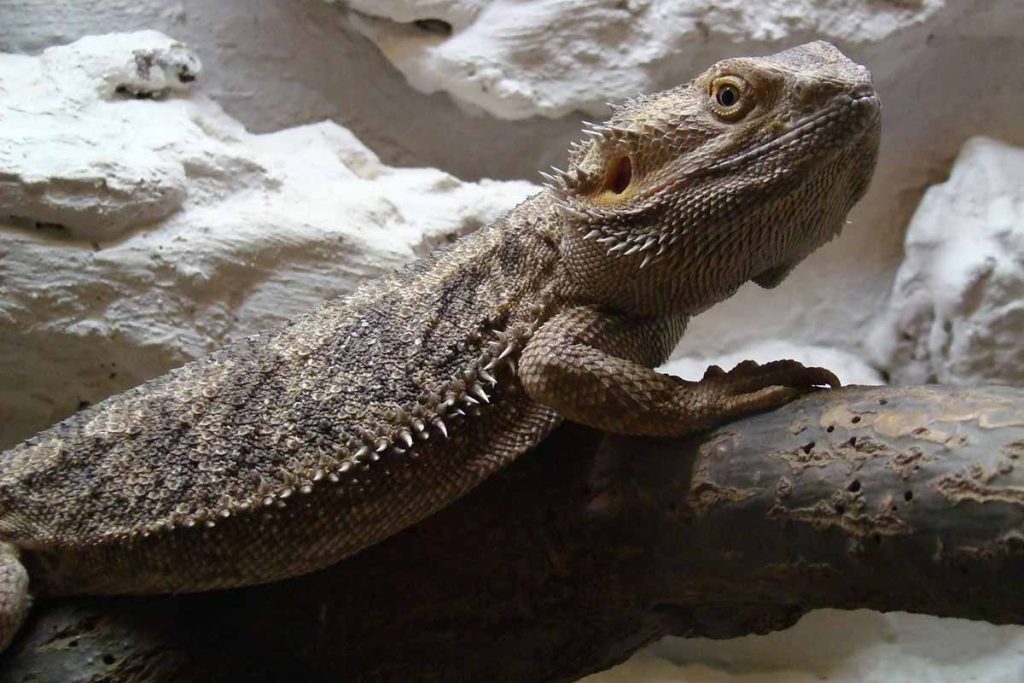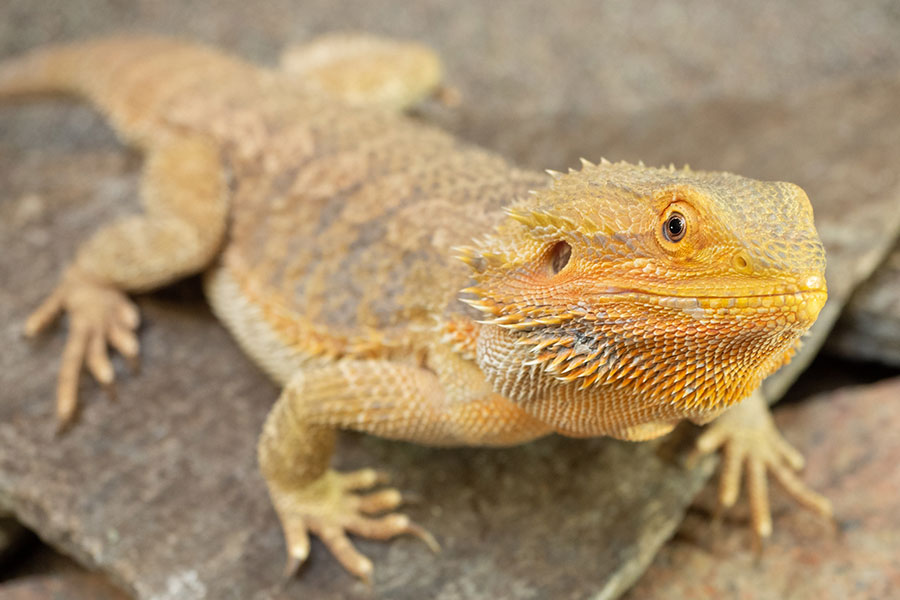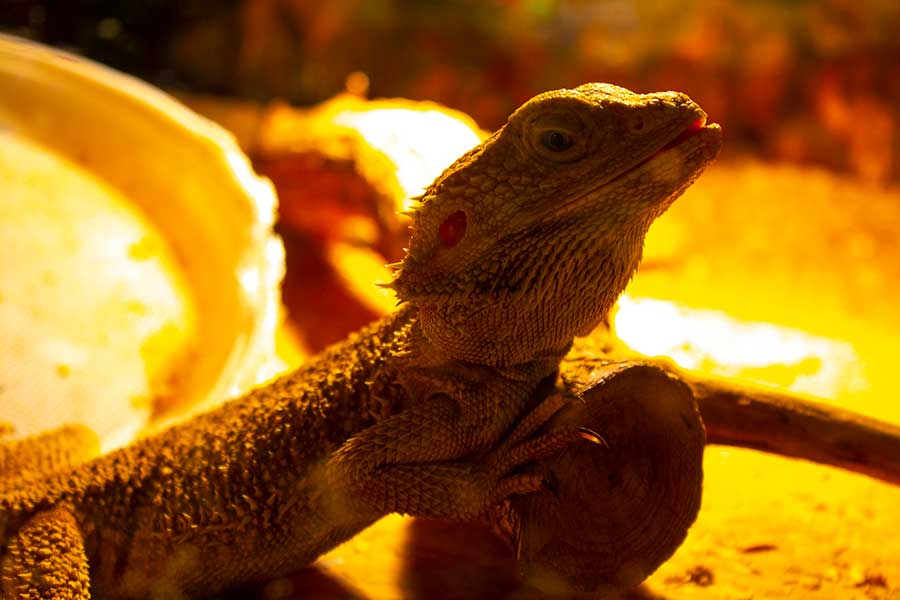While baby bearded dragons are incredibly cute, they don’t actually remain babies for long. In just the first few months of their lives, they can grow around two inches a month and shed twice a month to keep up. But what if your baby beardie doesn’t seem to be growing as expected?
This may not be your imagination. Healthy beardies grow incredibly quickly in the first six months of their lives, and if you aren’t noticing much growth, it could be a sign that something is wrong. Usually, growth issues are caused by the bearded dragon’s diet or their tank conditions. Fortunately, these issues are fairly easy to identify and correct.
In this article, we will share what to expect from your beardie’s growth and when you should worry they aren’t growing properly. We will then go through the main reasons your beardie’s growth might be stunted and what you can do to return them to a healthy rate of growth.
How Big Do Bearded Dragons Get?
To know whether your bearded dragon is growing as it should, you first need a pretty good idea of what size they should be at different ages. This is not always straightforward, and their future size mainly depends on what subspecies of bearded dragon they are.
The Pogona microlepidota only grows to be between 4 and 6 inches long, while the Pogona barbata can grow to between 20 and 24 inches. So, start by knowing what subspecies of bearded dragon you have. The most common variety of bearded dragon in the pet trade is Pogona vitticeps, which is better known as the central or inland bearded dragon. This particular variety grows to around 16 to 24 inches in length.
Nevertheless, across all subspecies, the majority of bearded dragons will reach somewhere between 12 and 20 inches when they are full grown. They will get most of that growth within the first three months of their lives, growing an average of about two inches per month.
After three months, their growth will slow down to about 1.5 inches per month until they are six months old and about full size. However, they will keep growing a little until they are between 12 and 18 months old.
While they are growing, you can expect bearded dragons to shed once or twice a month to keep up with their growth. As an adult, they might only shed a few times per year.
Bearded Dragon Growth Guide
To ensure your bearded dragon grows at a healthy rate and reaches their maximum potential size, you need to understand what factors affect their growth. These factors, such as diet, enclosure setup, potential health issues, and more can all either positively or negatively affect your beardie’s growth.
Factors Affecting Growth: Diet
Diet is one of the most critical factors when it comes to healthy growth. Nutrition is essential to let their bodies do what they need to do. They need enough food, the right type of food, and the right nutritional balance to grow at a normal, healthy rate.
Sufficient Food
Considering how fast bearded dragons grow in the first 3 to 6 months of their lives, they need to eat much more often than we imagine. In the first three months, they may need to eat as often as five times a day. This can be reduced to 3 to 4 times a day between 3 and 6 months. They can eat just twice a day from 6 to 18 months of age, and then just once a day after that once they are fully grown adults.
At each meal, you should generally give them as much as they can eat within a 10-minute period. Youths and juveniles should primarily eat animal based protein through crickets and other insects. They will gradually start to eat more plant matter as they get older.
Balanced Diet
Babies and juveniles need to get around 70% of their calories from animal/insect protein and 30% from plant matter. When they are fully grown, that ratio will flip to 70% plant matter and 30% protein. You’ll need to gradually adjust your beardie’s diet over time accordingly.
But while plants might form a relatively small part of a baby beardie’s diet, it is still essential, as it will be their main source of
Insufficient Calcium
Bearded dragons and other lizards need lots of
If they don’t get enough
How much
- Hatchlings require 650 mg of
calcium - Juveniles require around 1,100 mg of
calcium - Young adults need around 1,300 mg of
calcium - Adults need around 1,500 mg of
calcium .
Considering how important
Plants that contain
Add to this the fact that beardies can only use the
Read our complete guide to the bearded dragon diet here.
Factors Affecting Growth: Tank Conditions
As well as the right diet, bearded dragons bred in captivity need the right tank conditions to thrive. UVB light is essential for vitamin D3 production, but they also need the right tank temperature and tank size.
UVB Setup
We have already indicated why the right UVB setup is essential for your beardie’s tank. If they can’t get all the Vitamin D3 that they need, they will have weak bones that just refuse to grow, as they can’t utilize any of the
If your beardie’s tank is indoors, there is no way they can get enough sunlight naturally, so they need a powerful UVB light to replace the rays that they would usually get from the sun. They should have the opportunity to bask for at least 12 hours a day. Yes, that might end up being quite a drain on your electricity bill!
Also, remember that it is important to change their UVB light every six months, as they lose effectiveness quickly with consistent use.
Tank Temperature
Having your beardie’s tank at the right temperature is not just about their personal comfort. Their bodies also need to be at the right temperature in order to stimulate their appetite and digest their food correctly. Too hot or too cold, and they will lose interest in eating, and food may just sit in their stomachs rather than being correctly broken down and utilized.
Remember, as cold-blooded animals, lizards do not regulate their own body heat. They need to move between heat and cool spots often to keep their bodies at the correct temperature.
A UVB light will not be sufficient to heat up your bearded dragon’s tank to the correct temperature in most cases, and you will need to invest in separate heating equipment.
The temperature in their basking area should be between 95 and 100 degrees Fahrenheit. But at the same time, they need cool spots in their tank when they get their body to the temperature that they need. Cool spots should be between 75 and 80 degrees Fahrenheit. They also need cooler temperatures at night, to mimic their natural environment, with temperatures between 70 and 75 degrees Fahrenheit.
Tank Size
While the science on exactly how this works is unclear, it seems that tank size can also influence growth. Animals adapt to their environment, and if they have an environment that is too small for them, they may instinctively stunt their growth as a response. This can be noticed in behaviors such as lack of appetite.
Nevertheless, it is not recommended to pop your baby beardie directly into a very large tank, either, as this too can confuse their instinctive reactions. Still, they need to be moved to progressively larger tanks as they grow.
Depending on their subspecies, baby bearded dragons should be kept in a tank between 20 and 40 gallons in size. As they move into the juvenile period, their tank should double in size to 50 to 75 gallons. Meanwhile, adult beardies need a large tank of 75 to 120 gallons.
Read our guide on how to clear your bearded dragon’s tank.
Factors Affecting Growth: Parasites
Just like with cats and dogs, parasites can rob your bearded dragon of the nutrients they need to grow. They live inside the digestive system and eat the food that your lizard consumed before your beardie can break down and utilize it.
While parasites are hard to detect, they are surprisingly common for beardies in captivity, especially pinworms. They can cause diarrhea, but there are no other visual signs, and diarrhea can be caused by a variety of issues.
If your beardie is not growing or is losing weight and you can’t identify any other cause, it is worth talking to your vet about parasites. They will be able to assess your bearded dragon’s stool samples for the presence of parasites and develop a treatment plan moving forward if your beardie is infected.
Factors Affecting Growth: Sharing a Tank
If you love lizards so much that you have two beardies, and they are in the same tank, then it is extremely common for one of them to stop growing. This is because beardies are territorial and don’t like the company of other beardies.
Cohabitation, or having more than one bearded dragon sharing a tank together, often results in the larger of the two dominating the smaller one, preventing them from getting their fair share of food and causing stress that can also stunt growth. It is always better to keep your beardies in individual tanks.
Factors Affecting Growth: Poor Appetite
There are a variety of other reasons why your bearded dragon may not be eating, which will undermine their growth. Some will solve themselves with time, while others require active steps to correct the situation.
When beardies first move into a new home, they can be stressed by the sudden change in environment, so it can take a little while for them to feel comfortable eating normally. This is something that will usually solve itself with time.
But there are also things that can be happening in their environment that need correcting. It could be that there is too much noise or activity around their tank which is causing them stress. In this case, their tank should be moved to a more tranquil area of the home.
Other pets–and not just other beardies–can also be a source of stress. If your cat or dog is constantly prowling around the tank, your beardie will know about it!
Finally, it could be you! While beardies generally don’t mind being handled, it is easy to over-handle them and cause significant stress. This is especially true within the first month or two upon bringing them home, as they need to build up familiarity with you and handling over time.
So, if your beardie seems like they aren’t growing or eating, keep handling them to an absolute minimum. Ensure any stressors in and around their enclosure are kept to a minimum as well.
FAQs About Bearded Dragon Growth
How do I get my bearded dragon to grow?
The most important things to consider to ensure that your bearded dragon grows are the quality and quantity of their food. They need a varied diet made up of both insect protein and plant matter. They also need the right tank conditions, especially in terms of temperature and UVB light.
How long does it take a bearded dragon to grow?
While a beardie will reach around 80% of their full size within the first 6 to 8 months, they can keep growing until they are well over a year old. Larger species of bearded dragons will take longer to reach their full size.
The Verdict
Beardies grow incredibly quickly during the first six months of their lives. If your bearded dragon is not growing at a fast enough rate, there could be something amiss. Lack of growth in beardies is usually the result of a problem with their diet or a problem with their tank conditions.
Fortunately, these are both things that you can control, so it is within your power to return them to health.
What are your top tips for keeping bearded dragons healthy? Share them with the community in the comments section below.




